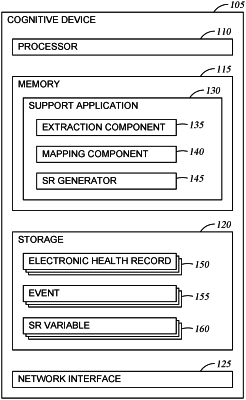| CPC G16H 50/20 (2018.01) [G06N 20/00 (2019.01); G16H 10/60 (2018.01); G16H 10/40 (2018.01)] | 17 Claims |

|
1. A method, comprising:
training a first set of one or more machine learning models, based on one or more stimulus-response (SR) variables defined by a user, to define new SR variables;
defining a new SR variable using the trained first set of one or more machine learning models, wherein the new SR variable indicates whether patient engagement increases in response to adverse events;
determining, for each respective patient of a plurality of patients, a respective value of the new SR variable;
validating the new SR variable by determining, based on the respective values of the new SR variable, that the new SR variable has a statistically significant correlation with a defined patient outcome;
extracting a plurality of events from a plurality of electronic health records associated with a first patient, wherein the plurality of electronic health records correspond to a defined period of time;
analyzing the extracted plurality of events using the trained first set of one or more machine learning models to identify a plurality of stimulus events and a plurality of response events, wherein only the plurality of electronic health records corresponding to the defined window of time are analyzed, comprising:
classifying a first event of the extracted plurality of events as a first stimulus event, based at least in part on determining that the first event corresponds to new information received by the first patient, wherein the new information relates to a first medical disorder,
classifying a second event of the extracted plurality of events as a first response event, based at least in part on determining that the second event corresponds to an action taken by the first patient, wherein the action is clinically unrelated to the first medical disorder,
classifying a third event of the extracted plurality of events as a second stimulus event, and
excluding the second stimulus event from the extracted plurality of events, based on determining that a deadline associated with the second stimulus event has not passed;
determining, using the trained first set of one or more machine learning models, a link between the first stimulus event and the first response event, based on determining that the first patient took the action in response to receiving the new information, wherein the action is clinically unrelated to the new information;
generating a value for the new SR variable with respect to the first patient based at least in part on the determined association, wherein the value for the new SR variable indicates a ratio between a number of healthcare appointments scheduled for the first patient and a number of healthcare appointments completed by the first patient corresponding to the defined period of time, and a time elapsed between the first stimulus event and the first response event; and
in response to validating the new SR variable, training one or more predictive machine learning models to predict patient outcomes using the new SR variable, based at least in part on the generated value for the new SR variable with respect to the first patient.
|